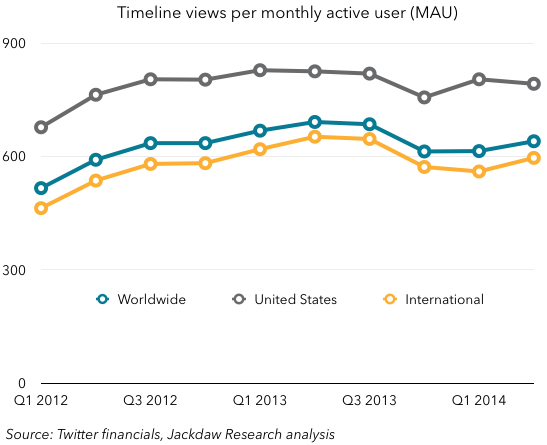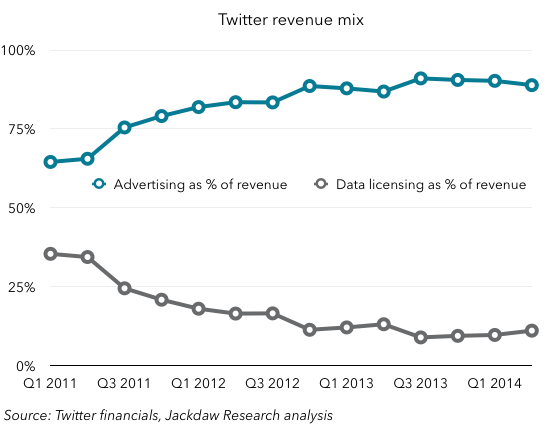Note: This is part of a series on major tech companies’ Q2 2014 earnings (e.g. Google here, Microsoft here, Apple here and here, Netflix here, Facebook here and Amazon here). My post about Twitter’s earnings last quarter is here.
Non-logged-in users and “Twitter Everywhere”
I posted yesterday evening about the growth challenge that Twitter faces (and which it shares with Foursquare). Given the focus during today’s earnings call on non-logged-in users, I’d say this is very much at the top of Twitter executives’ minds at the moment too. Let’s dig into that a bit. I was reminded of something I read quite a while ago on Fred Wilson’s blog:
Let’s remember one of the cardinal rules of social media. Out of 100 people, 1% will create the content, 10% will curate the content, and the other 90% will simply consume it.
It occurred to me during today’s earnings call that Twitter is experiencing this in quite a different way from some other services. Facebook and other social networks require you to log in to gain any meaningful benefit from interacting with the service, because Facebook posts are largely private and because the benefit is largely derived from seeing posts from people you know. As such, this 1%/10%/90% split Fred Wilson talks about largely applies to logged in users. But with Twitter, the big difference is that the vast majority of posts are public, and therefore people don’t have to be logged in at all to get value out of the service. So, in fact, the logged-in monthly active users Twitter has reported so far (271 million at the end of June) might represent some mix of the 1% and 10%, while Twitter might very adequately serve the other 90% as non-logged-in users. This is what drove much of Dick Costolo’s prepared remarks during the call: that the real size of Twitter is a multiple of the size it appears to be based on the number of monthly active users (MAUs) it reports.
It turns out that I had forgotten the context in which Fred Wilson quoted those numbers, which was an account of a state of the union address Dick Costolo gave at Twitter HQ in September 2011. During that session, Costolo very much hit on the same theme he returned to on today’s call, and I direct you to Wilson’s post for a recounting of some of the key points. What’s very interesting is that back then Costolo was quoting a 4:1 ratio of total users to logged-in users, or about the same 3x multiple of non-logged-in to logged-in users he quoted on today’s call. What’s surprising is that Costolo doesn’t seem to have talked very much about this in the three years between then and now (if you search for Costolo Logged In Users on Google, you’ll find posts from 2011 and today, but almost nothing in between). But I wouldn’t be at all surprised to see some sort of unique users metric emerge next quarter now that Costolo has provided the strategic rationale for measuring it. The challenge will be monetizing these users going forward, something Twitter doesn’t even attempt to do today.
Downplaying the World Cup while learning lessons
Costolo and the other executives on the call were also very keen to both play up and downplay the impact of the World Cup. On the one hand, they want to play it up as an example of what Twitter can do on an ongoing basis by way of creating topic- and event-driven experiences that are different from the classic Twitter feed. On the other, they were keen to downplay the impact of the World Cup specifically as a factor in driving the strong MAU growth it saw this quarter. On the other hand, they suggested the World Cup did have an effect on engagement, which is definitely illustrated by this stark contrast in sequential MAU growth from Q1 to Q2 (turns out the US still doesn’t care much about soccer):
 Look at the difference in Twitter’s key engagement metric from Q1 2014 (no World Cup) to Q2 2014 (World Cup). International engagement rose, while US engagement actually fell. You can see this in the shape of the overall graph for timeline views per MAU, which appeared to improve in Q2 but were largely driven by International growth:
Look at the difference in Twitter’s key engagement metric from Q1 2014 (no World Cup) to Q2 2014 (World Cup). International engagement rose, while US engagement actually fell. You can see this in the shape of the overall graph for timeline views per MAU, which appeared to improve in Q2 but were largely driven by International growth:
 The big question is to what extent the World Cup experience is replicable for other events and topics, which is clearly Twitter’s plan. The World Cup is either the most or second-most watched event in the world (sporting or otherwise), and along with the Olympics only happens every four years. Putting a lot of investment into creating a curated experience around the World Cup clearly makes sense, and its major news bites make for good tweets because they’re short and to the point (Brazil 7, Germany 1 takes considerably fewer than 140 characters).
The big question is to what extent the World Cup experience is replicable for other events and topics, which is clearly Twitter’s plan. The World Cup is either the most or second-most watched event in the world (sporting or otherwise), and along with the Olympics only happens every four years. Putting a lot of investment into creating a curated experience around the World Cup clearly makes sense, and its major news bites make for good tweets because they’re short and to the point (Brazil 7, Germany 1 takes considerably fewer than 140 characters).
But how does this experience translate to hundreds of other events and topics Twitter would want to do this for, and to what extent can those experiences be machine- rather than human-curated? Twitter has just 3300 employees – how many of them can it afford to attach to human curation projects for the many other events and topics Twitter might want to recreate the World Cup experience for? And would there be any meaningful return on that investment for most of those events? If the World Cup drove a small increase in engagement for international users, how many events that happen more frequently would it have to bundle together to drive a similar impact?
Data and Licensing is growing faster
Twitter, like Facebook and Google, derives about 90% of its revenue from advertising. However, unlike Facebook, which is deriving an ever-greater proportion of its revenues from advertising, Twitter has actually quietly been going in the opposite direction for the previous two quarters and just took a slightly bigger step in that direction this quarter:
 The reason is that Data and Licensing revenue actually grew as a proportion of total revenue over the last several quarters, and accounted for 11.1% of revenue in Q2. There wasn’t much detail on the earnings call, but the 42% sequential and 90% year on year increase was put down to a combination of the Gnip acquisition (which closed in April) and revenue from the mobile ad exchange (the former MoPub). Presumably, much of the revenue generated by the MoPub business is actually recorded in the advertising line, but a portion apparently comes from Data and contributed to this growth. In my post on Facebook’s earnings I worried about their increasing reliance on mobile advertising and the paucity of other possible revenue sources in the near term, so I think this secondary revenue stream for Twitter (albeit still small) is important.
The reason is that Data and Licensing revenue actually grew as a proportion of total revenue over the last several quarters, and accounted for 11.1% of revenue in Q2. There wasn’t much detail on the earnings call, but the 42% sequential and 90% year on year increase was put down to a combination of the Gnip acquisition (which closed in April) and revenue from the mobile ad exchange (the former MoPub). Presumably, much of the revenue generated by the MoPub business is actually recorded in the advertising line, but a portion apparently comes from Data and contributed to this growth. In my post on Facebook’s earnings I worried about their increasing reliance on mobile advertising and the paucity of other possible revenue sources in the near term, so I think this secondary revenue stream for Twitter (albeit still small) is important.